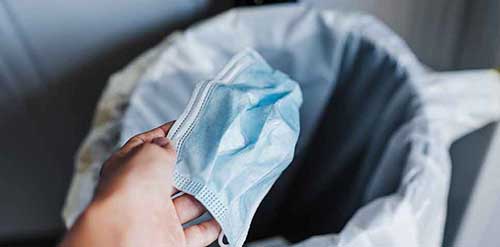Hyundai Motorstudio Senayan Park
Hyundai Motorstudio Senayan Park
Newsroom
The official news from Hyundai Motorstudio Senayan Park and a collection of innovative articles on mobility and sustainability here.
-
6 Tips for Disposing Mask Waste in Correct Manner
- Hyundai Motorstudio Senayan Park Senayan Park 2022.06.13
-
Masks are an important part in preventing the corona virus from spreading during the pandemic, and now it has become an everyday accessory. But there is one negative effect, mask waste is everywhere!
The environment is clearly suffering because of the new waste that was not previously expected. Masks are effective in reducing the spread of the corona virus for humans, but masks are a disaster for nature.
Ideally, mask waste should be treated like medical waste in general, so it must be handled differently. But how to manage the mask waste?
Impact of Waste Masks for the Environment
When the pandemic was at its peak, waste masks were found in various places. Disposable masks are almost visible in every public area, and this happens in almost all cities in the world.
Waste masks have begun to appear on the beach, and this is a warning because it can damage marine life and its ecosystem. Apart from being pollution, mask waste can be a medium for spreading the virus.
Approaching the end of the pandemic, new eco-friendly masks came out. This is a bit too late because most of the masks have polluted the environment. The current mask design uses three different layers: the innermost layer is cotton, the middle layer is polypropylene, and the outermost layer is polyester.
This is different from the initial design, which the second layer uses a non-woven fabric material, commonly called a TNT. Non-woven fabrics are known not to be eco-friendly because they are difficult to decompose. The TNT material is known to be practical and inexpensive, so it is widely used.
Perhaps, the management of mask waste has become a forgotten point during the pandemic, though this is equally important in preventing the transmission through used masks.
6 Tips for Managing Mask Waste
Using masks has become a daily routine, but this has a big impact on mask waste. Handling mask waste is not yet difficult, though it’s not easy either. The following points can be your guide for managing mask waste.
1. Take off the Mask
Approaching the end of the pandemic, there are many people who have not been able to wear a mask correctly, as well as when removing a mask. As a rule, the inside of the mask must be protected from any contact, either when wearing or removing.
Looking at the general design of the mask, the innermost layer is only used to provide comfort. Only the middle layer and the outer layer are in charge of filtering viruses.
So, when removing the mask, start by removing the strap behind the ear or head. This will ensure that your hands don't touch the inside of the mask as it contains viruses, bacteria and germs.
2. Folding Mask
To avoid exposing the innermost layer to air, fold the mask as soon as it is removed. This will ensure that any droplets or viruses are trapped inside. Viruses are able to survive for different durations, from a few hours to several days.
So, the wisest advice is not to throw the used masks because they can pose a danger. The virus continues to mutate and transmit through the air. That's why it's important to fold the mask before disposing it.
3. Use Disinfectant
Infected mask waste may contain respiratory secretions that can be spread and transmit through the air. So, always wash your hands after removing the mask. For some cases, hand washing does not solve the problem of contamination.
Disinfection is a concrete step that must be done after removing the mask. It will ensure that the virus is neutralized so it doesn't develop further. Disinfection can be done with alcohol, bleach, and chlorine.
For cloth masks, bleach can be used. While for medical masks and N95, alcohol works better in killing viruses. Whether or not they can be reused after disinfecting will depend on the mask.
Especially when you have a cold or cough, the inside of the mask is usually moist, even wet. In this case, it is better not to use the mask again even after disinfected.
4. Tear the Mask
Masks are sometimes disposed as is. Because it is still in good shape, there are people who may use it again. To prevent this, tear the mask before disposing it away. After the mask is folded into two parts and disinfected, try cutting it to make it torn and unfit for use.
5. Wrap the Mask
Because it is classified as medical waste, mask waste should not be thrown away. After applying the points above, the mask should be wrapped first. In this way, the classification of medical waste will be reduced to domestic waste.
Wrapping the waste masks is the last precaution so that the virus, if any, does not make any contact, even with other garbage.
6. Clean Up
Depending on how the handling process is carried out, self-cleaning is a must. If the mask is only used for personal protection, hand washing is enough.
It's a bit different if the virus comes from a patient with severe symptoms, for example a suspected corona. Cleaning the whole body is definitely more recommended to ensure that no virus is left behind.




